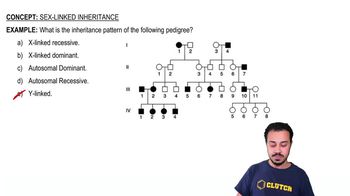Table of contents
- 1. Introduction to Biology2h 40m
- 2. Chemistry3h 40m
- 3. Water1h 26m
- 4. Biomolecules2h 23m
- 5. Cell Components2h 26m
- 6. The Membrane2h 31m
- 7. Energy and Metabolism2h 0m
- 8. Respiration2h 40m
- 9. Photosynthesis2h 49m
- 10. Cell Signaling59m
- 11. Cell Division2h 47m
- 12. Meiosis2h 0m
- 13. Mendelian Genetics4h 44m
- Introduction to Mendel's Experiments7m
- Genotype vs. Phenotype17m
- Punnett Squares13m
- Mendel's Experiments26m
- Mendel's Laws18m
- Monohybrid Crosses19m
- Test Crosses14m
- Dihybrid Crosses20m
- Punnett Square Probability26m
- Incomplete Dominance vs. Codominance20m
- Epistasis7m
- Non-Mendelian Genetics12m
- Pedigrees6m
- Autosomal Inheritance21m
- Sex-Linked Inheritance43m
- X-Inactivation9m
- 14. DNA Synthesis2h 27m
- 15. Gene Expression3h 20m
- 16. Regulation of Expression3h 31m
- Introduction to Regulation of Gene Expression13m
- Prokaryotic Gene Regulation via Operons27m
- The Lac Operon21m
- Glucose's Impact on Lac Operon25m
- The Trp Operon20m
- Review of the Lac Operon & Trp Operon11m
- Introduction to Eukaryotic Gene Regulation9m
- Eukaryotic Chromatin Modifications16m
- Eukaryotic Transcriptional Control22m
- Eukaryotic Post-Transcriptional Regulation28m
- Eukaryotic Post-Translational Regulation13m
- 17. Viruses37m
- 18. Biotechnology2h 58m
- 19. Genomics17m
- 20. Development1h 5m
- 21. Evolution3h 1m
- 22. Evolution of Populations3h 52m
- 23. Speciation1h 37m
- 24. History of Life on Earth2h 6m
- 25. Phylogeny2h 31m
- 26. Prokaryotes4h 59m
- 27. Protists1h 12m
- 28. Plants1h 22m
- 29. Fungi36m
- 30. Overview of Animals34m
- 31. Invertebrates1h 2m
- 32. Vertebrates50m
- 33. Plant Anatomy1h 3m
- 34. Vascular Plant Transport2m
- 35. Soil37m
- 36. Plant Reproduction47m
- 37. Plant Sensation and Response1h 9m
- 38. Animal Form and Function1h 19m
- 39. Digestive System10m
- 40. Circulatory System1h 57m
- 41. Immune System1h 12m
- 42. Osmoregulation and Excretion50m
- 43. Endocrine System4m
- 44. Animal Reproduction2m
- 45. Nervous System55m
- 46. Sensory Systems46m
- 47. Muscle Systems23m
- 48. Ecology3h 11m
- Introduction to Ecology20m
- Biogeography14m
- Earth's Climate Patterns50m
- Introduction to Terrestrial Biomes10m
- Terrestrial Biomes: Near Equator13m
- Terrestrial Biomes: Temperate Regions10m
- Terrestrial Biomes: Northern Regions15m
- Introduction to Aquatic Biomes27m
- Freshwater Aquatic Biomes14m
- Marine Aquatic Biomes13m
- 49. Animal Behavior28m
- 50. Population Ecology3h 41m
- Introduction to Population Ecology28m
- Population Sampling Methods23m
- Life History12m
- Population Demography17m
- Factors Limiting Population Growth14m
- Introduction to Population Growth Models22m
- Linear Population Growth6m
- Exponential Population Growth29m
- Logistic Population Growth32m
- r/K Selection10m
- The Human Population22m
- 51. Community Ecology2h 46m
- Introduction to Community Ecology2m
- Introduction to Community Interactions9m
- Community Interactions: Competition (-/-)38m
- Community Interactions: Exploitation (+/-)23m
- Community Interactions: Mutualism (+/+) & Commensalism (+/0)9m
- Community Structure35m
- Community Dynamics26m
- Geographic Impact on Communities21m
- 52. Ecosystems2h 36m
- 53. Conservation Biology24m
13. Mendelian Genetics
Sex-Linked Inheritance
Struggling with General Biology?
Join thousands of students who trust us to help them ace their exams!Watch the first videoMultiple Choice
Which of the following results of Thomas Hunt Morgan's experiments with white-eyed mutant flies was unexpected in light of Mendelian genetics?
A
In the parental cross, a white-eyed male was crossed with a red-eyed female. The F1 progeny all had red eyes.
B
The F1 flies were crossed with each other, and the F2 progeny included red-eyed and white-eyed flies in a 3:1 ratio.
C
The mutant allele (white eyes) was recessive.
D
All of the listed responses are correct.
E
Among the F2 progeny, only males had white eyes. All of the females had red eyes.
 Verified step by step guidance
Verified step by step guidance1
Understand the basics of Mendelian genetics: In Mendelian inheritance, traits are determined by alleles, which are different forms of a gene. Typically, one allele is dominant and the other is recessive. In a simple Mendelian cross, a 3:1 phenotypic ratio in the F2 generation is expected if the trait is controlled by a single gene with two alleles, one dominant and one recessive.
Review the experiment setup: Thomas Hunt Morgan crossed a white-eyed male fly (mutant) with a red-eyed female fly. The white-eyed trait is recessive, meaning that the red-eyed allele is dominant over the white-eyed allele.
Analyze the F1 generation: All F1 progeny had red eyes, indicating that the red-eyed allele is dominant. This is consistent with Mendelian genetics, where the dominant trait is expressed in the presence of a recessive allele.
Examine the F2 generation results: When the F1 flies were crossed, the F2 generation showed a 3:1 ratio of red-eyed to white-eyed flies. However, the unexpected result was that only males had white eyes, while all females had red eyes.
Consider the concept of sex-linked traits: The unexpected result suggests that the white-eyed trait is linked to the sex chromosomes. In Drosophila, the gene for eye color is located on the X chromosome. Males have one X and one Y chromosome (XY), while females have two X chromosomes (XX). Since the white-eyed allele is recessive and located on the X chromosome, males (having only one X chromosome) will express the white-eyed trait if they inherit the recessive allele, while females would need two copies of the recessive allele to express the trait.

 4:17m
4:17mWatch next
Master Sex-Linked Inheritance with a bite sized video explanation from Jason Amores Sumpter
Start learningRelated Videos
Related Practice











